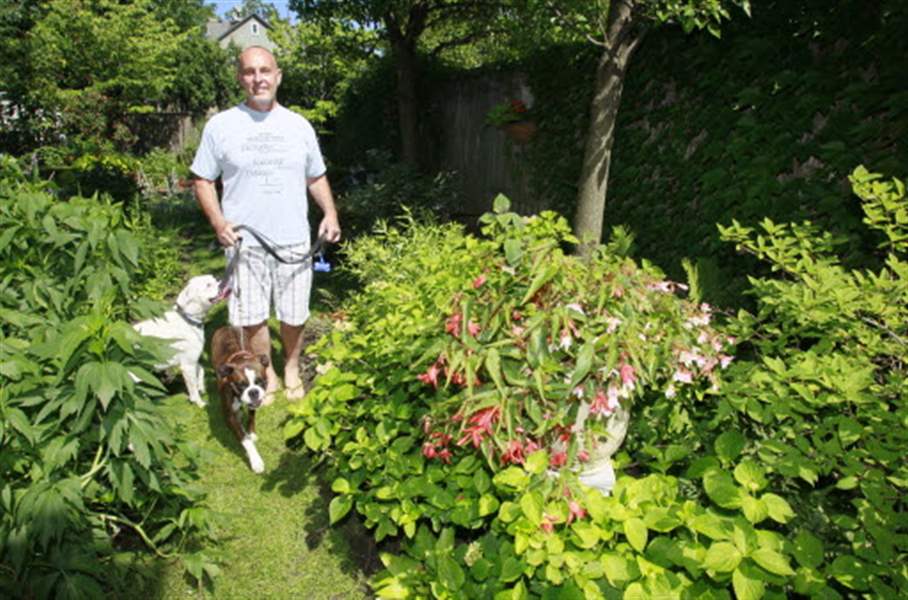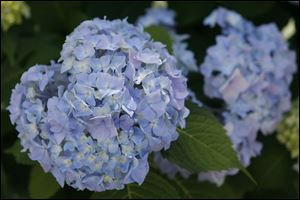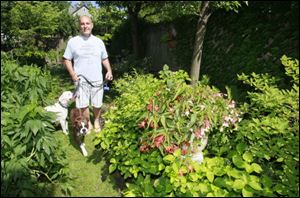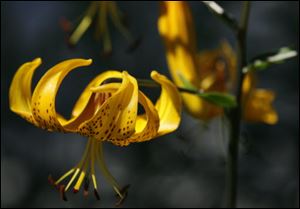
Dave Urbank: 'My garden is my church'
7/16/2011
Dave Urbank in his garden in the Old West End.
THE BLADE/JEREMY WADSWORTH
Buy This Image

Hydrangeas bloom in Dave Urbank's Old West End garden.
The Blade seeks gardeners for Weed It & Reap who are as varied as what they grow and who dig in gardens large, small, or with unusual content. In a sentence, tell us what is unique about you or your garden. Contact Tahree Lane at tlane@theblade.com or 419-724-6075.
Name: Dave Urbank, membership sales manager at the Toledo Museum of Art, living in the Historic Old West End.
Garden specs: My lot is 50-by-156-feet and my garden is almost the entire yard behind my 1899 foursquare-style home. It includes a small brick patio.
When did you start gardening? As a child, I lived in Peninsula (north of Akron) very close to my grandparents who were both avid flower and vegetable gardeners. They had currant bushes, incredible irises, peonies, roses, and lots of flowering shrubs. At first, I was ordered by my parents to help my grandparents with their garden work, but soon I didn't need to be asked. I was hooked and I've been gardening ever since. My parents once had more than 3,000 daffodils in bloom.
What do you grow? Sixteen hydrangeas, perennials (phlox), and annuals that reseed each year (notably, nicotiana).
Favorite plant: Hydrangeas and hostas; hydrangeas because of their showy, long-lived flowers and hostas because of their dramatic foliage. Both are hardy plants that stand up to Midwestern summers but the hydrangeas need a lot of water, especially when flowering. Hydrangeas bloom in waves; first are the blues, then the old-fashioned whites, then the pinks, and finally the Lime Lights in late July. And in the fall, the flowers turn different colors that become intensified after a light frost. The blues turn this wonderful shade of green with a pink/maroon cast; the bright pinks become maroon; the limes turn a peachy-orange; and the white ones turn to a bright lime green. They're fascinating plants. They like sun to part sun. I dry the large flower them by stripping off the leaves, putting them in a vase with a little water, and letting them dry in place.

Dave Urbank in his garden in the Old West End.
And, don't be afraid to experiment each year: Try different accent plants or combinations to give your garden a fresh look. I have a lot of lime/chartreuse colors, so I've been adding bright orange, including orange Firecracker fuchsias, and coleus in shades of orange and garnet.
Also, include some focal points that will lead the eye and provide depth and structure. I've created a grass pathway through the garden, have a column with a dramatic pot on it, and an old Chinese bowl with water-loving miniature papyrus, cardinal flower, and a crazy plant that looks like corkscrews. There's a weathered teak bench and a black iron urn filled with bright annuals.
Hours spent gardening: In the spring, maybe 10 to 15 hours per week because there's cleaning up, transplanting, mulching, and planting a dozen containers. Once that's done, my work is reduced to about 4 to 6 hours per week.

A lily in Dave Urbank's garden in Toledo.
Challenges: I have a small space and need to be very selective in choosing the correct plant in terms of scale. I love an abundant-looking garden so I'm always walking a tightrope between lush and overgrown. I take inventory in late summer and decide what I'll eliminate or divide the following spring. I've removed several shrubs that grew too large for my space.
I'm proud of the fact that ten years ago, I started with an empty backyard save for one black locust tree. Now I have a garden that looks like it's been here for decades. Also that I'm able to give friends and neighbors gifts of plants from my garden.
What I've gotten out of gardening is how it refreshes my soul and calms my spirit. I often say that my garden is my church; it is where I feel as one with the universe.